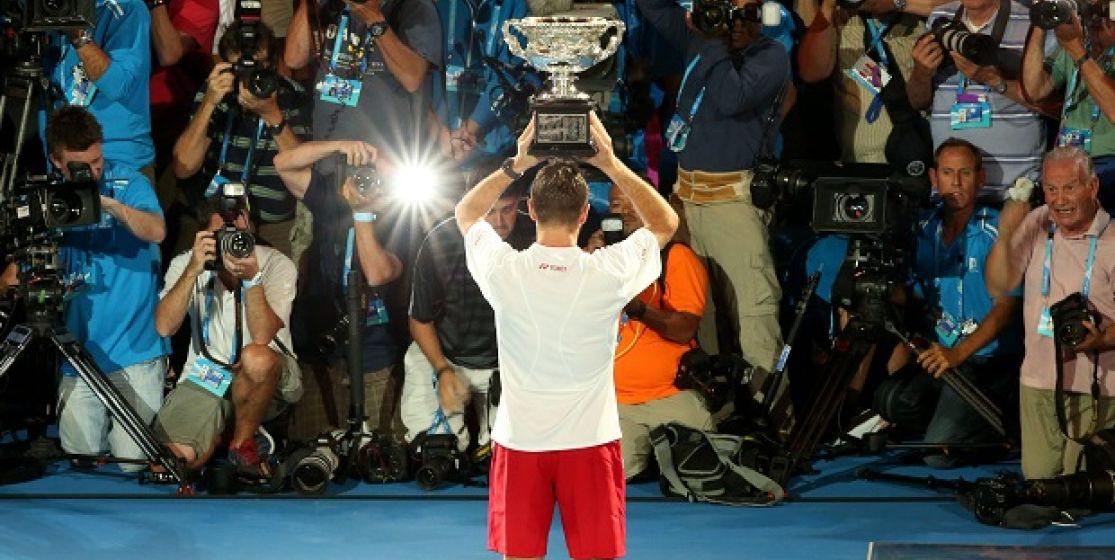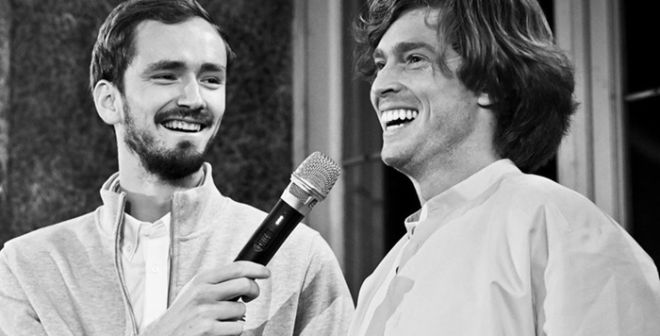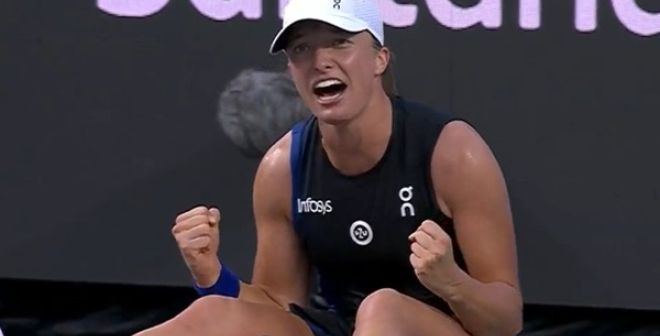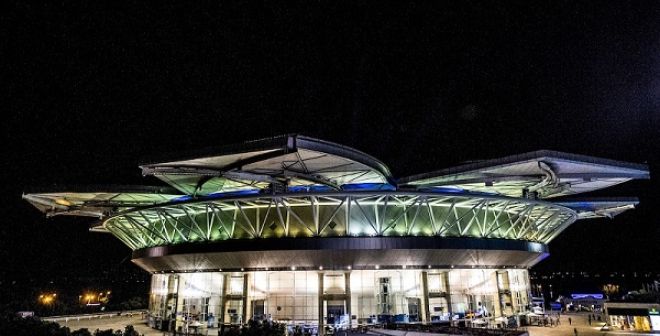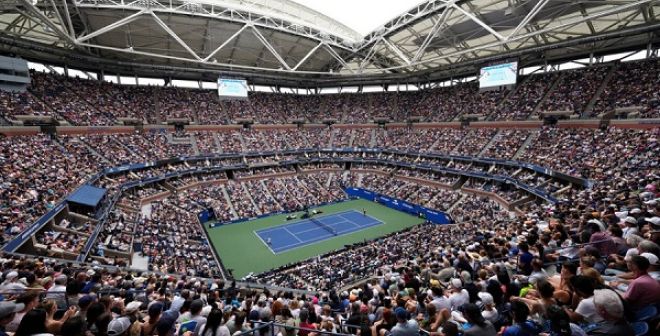Of course, there was the heat wave, Li Na and Stanislas Wawrinka. But before reaching its grand finale, the Australian Open has been eventful to say the least. Let's take the film and rewind.
Rafter gives a lesson
Tennis players are fans like any others. So when the former world No. 1 Patrick Rafter decided to take the racquets the time of a match with Lleyton Hewitt, they were many, like Matthew Ebden and Ivo Karlovic, to hurry in the stands to observe one of last serve-and-volley player winner in Grand Slams. Observe, and perhaps take a lesson: "Even if he retired ten years ago, he can still volley better than all the players on tour at the moment, said Patrick Mouratoglou, Serena Williams's coach. It’s very simple: no player can volley like that today. He’s still exceptionally good, we don't see services like that anymore on the tour, with plenty of spin to allow time to come to the net and ideally prepare for the first volley. He has a sense of the game at the net." Talent never fades.
Magnus Maximus
Becker? Edberg? Lendl? All wrong. The star coach of the fortnight has never won a single Grand Slam title as a player, despite a final in Roland Garros in 2000. His name is Magnus Norman and he emerged as the leader of the new coaches arrived on the tour in recent years. After accompanying Robin Söderling at the gates of the dream at Roland Garros in 2009 and 2010, Norman had taken a step back until the repeated calls from Stanislas Wawrinka, which made him come back a year ago. As his protégé, the Australian Open was his first major title as a coach. Oddly, he became the only coach to have defeated Rafael Nadal in Grand Slams with two different players: Robin Soderling at Roland Garros in 2009 and Wawrinka in the final in Melbourne. His nemesis?
The greatest victory
His name probably doesn't mean anything to you, but the greatest victory of this Australian Open is to be credited to Ross Hutchins. He's British, 28 years old, and is a doubles specialist. In Melbourne, he won his first match on the tour since 2012. What happened in the meantime? A year 2013 spent far from the courts, fighting Hodgkin's lymphoma, a form of cancer that has the peculiarity to affect a very young population. So, just a year ago, Hutchins was starting his chemotherapy. On the 15th of January 2014, associated with Colin Fleming, he officially became a professional tennis player again by scoring the first ATP points of his second career against Marinko Matosevic and Michal Przysiezny. Hats off... Even if he really doesn't want "people to take pity on him": "Last week, a player apologized for beating me. I don't want that. I want to be a tennis player like another. Congratulate me when I'll win a Grand Slam title."
Jiang Shan, the quiet man
We're only in January and the prize for the most inappropriate acceptance speech of the year has already been awarded to Li Na: "To Max my agent, you made me very rich. Thanks a lot. And of course, my husband. He's even famous in China. So thanks for him giving up everything, travelling with me to be my hitting partner, fix the drinks and fix my racquets. He does a good job so thanks a lot. You are a nice guy. Also, you are so lucky for me." Awkward moment in the audience.
Busy Balkans
Ten years ago, in the wake of the Russian dolls Sharapova, Kuznetsova and Myskina, the future was written in Cyrillic. Today, the new breeding-ground of world tennis is in a much smaller region, but a much denser one too: the Balkans. A fragmented geographical area but where the successes of Novak Djokovic, Ana Ivanovic and Jelena Jankovic have generated an incredible dynamic. While Serbia is still on top with three champions, Bulgaria has tremendous hopes in Grigor Dimitrov, Croatia has Borna Coric (World #1 in Junior in 2013) and Ana Konjuh (World #2 in Junior in 2013) while Romania has Simona Halep and Sorana Cirstea... Even the smallest countries in the area have a respectable contingent of representatives in the Top 100, like Slovenia with Blaz Kavcic and Polona Hercog. The list is even more impressive when you look at the extended diasporas due to the war: Bernard Tomic (Croatia, Bosnia), Nick Kyrgios and Thanasi Kokkinakis (Greece) all wear the colours of Australia, the small American pearl Stefan Kozlov comes from Macedonia and Milos Raonic (Montenegro) represents Canada... One hell of a Greek salad to announce a feast of success in the coming years?
Robert broke the bank
A week earlier, they were losing in the final round of the qualifying. Even before the "real" tournament started, the Australian Open was already over for them. And then, thanks to the forfeits of highest ranked players, Stephane Robert and Martin Klizan were invited to the party as "lucky losers". Opportunistic and relaxed, the two men took advantage of the tables inherited from a top seed (Kohlschreiber for the French, Isner for the Slovak) ...So much that they actually found themselves in the third round! On cloud nine, Robert became, at age 33, the oldest player of the Open era to discover the second week of a Grand Slam tournament. The adventure earned him more than 80 000£... almost as much as his entire 2013 season. It was worth paying an additional fee to change, round after round, his plane ticket back to France!
No holds barred
In 2013, Victoria Azarenka and Sloane Stephens were fighting for a place in the final of the Australian Open. This year, the fact that their roads crossed from the knockout stages didn't prevent sparks. The only drama this time came early in the first set when Stephens hit a passing shot aimed straight at Azarenka. Not convinced by the apology of the American, the World No. 2, glower, got her chance to hit back from the following point. Stephens chose to smile... Not Azarenka: "She made her choice. She had a big open court but she chose this one. Ok, I have no problem with that. I always think about the next point."
An awful afternoon
There are days when it would be better to stay in bed. Marinko Matosevic, 28 and 12 defeats in the first round in as many attempts in Grand Slams, can confirm it. The latest, and perhaps the worst was against Kei Nishikori. Act I of the play 'Marinko against the world': The Aussie gets a penalty point for having quenched his thirst between two points, while the thermometer was showing a temperature above 42°C on the court. Act II: Some "Mad Dog! Mad Dog!" started to echo in the stands. Annoyed, Matosevic turned to the referee "Can you please tell them to shut up? Mad Dog has never been my nickname. It's an idiot who wrote that on my Wikipedia page!" Act III: he gets angry against a fan of Nishikori who shouted "Out!" on a forehand worth a break in his favour in the third set. Point to replay, lost point... and soon lost set then lost game. Act IV finally, the press conference of the exasperated player where someone had the good idea to remind him of his bad ratio in Grand Slams: "I don't care dude. What do you want me to say?" Life's a bitch.
The future Hingis
When Belinda Bencic was born in March 1997, Kimiko Date was just finishing her first professional chapter, rich of three Grand Slam semi-finals during Steffi Graf's best years. Sixteen years later, the Swiss and the Japanese met in the first round of the Australian Open, ending by a victory for the teenager on her senior of... 27 years. Kimiko Date, now aged 43, probably think that she saw the ghost of another feline Swiss tennis player, Martina Hingis. Who spoke to Bencic before the match: "She gave me some advices, I tried to apply them, said the 2013 junior world champion. She knew my opponent better than me as they've met on the tour in the past." It was at the Masters in 1996. Kimiko Date lost. Belinda Bencic wasn’t even born yet.
Cartoons and Comics
This Australian Open was all about cartoon characters. It started with Frank Dancevic, hallucinating under the scorching heat in the first week. "We were in the middle of the first set when suddenly I saw Snoopy on the court. I thought: 'Wow Snoopy! This is awkward. This is the last thing I remember before waking up on the ground, with lots of people around me.’" No need of sunshine however to stimulate the imagination of Gael Monfils. Invited by the French newspaper L'Equipe to associate each champion with a superhero, the French answered with great timeliness. Nadal? "He has a lot of strength and power, but for me, he would be someone smart. Like Captain America." Djokovic? "Mr Fantastic, the elastic man of the Fantastic Four. A really clever character like Djoko on the courts. When you look at Novak, he doesn't look like much. But he’s actually really fit, really elastic, and really intelligent. It's the same with the guy in the Fantastic Four... He looks pretty shitty, but he's actually amazing!" Federer? "Magneto. Very intelligent, very strong and very elegant. He’s here, but you cannot quite touch him. That, too, is Roger." And finally Murray: "Johnny Storm of the Fantastic Four. Nervous, powerful, fast, impulsive and very strong. And he can get a flying start, just like Andy!"


